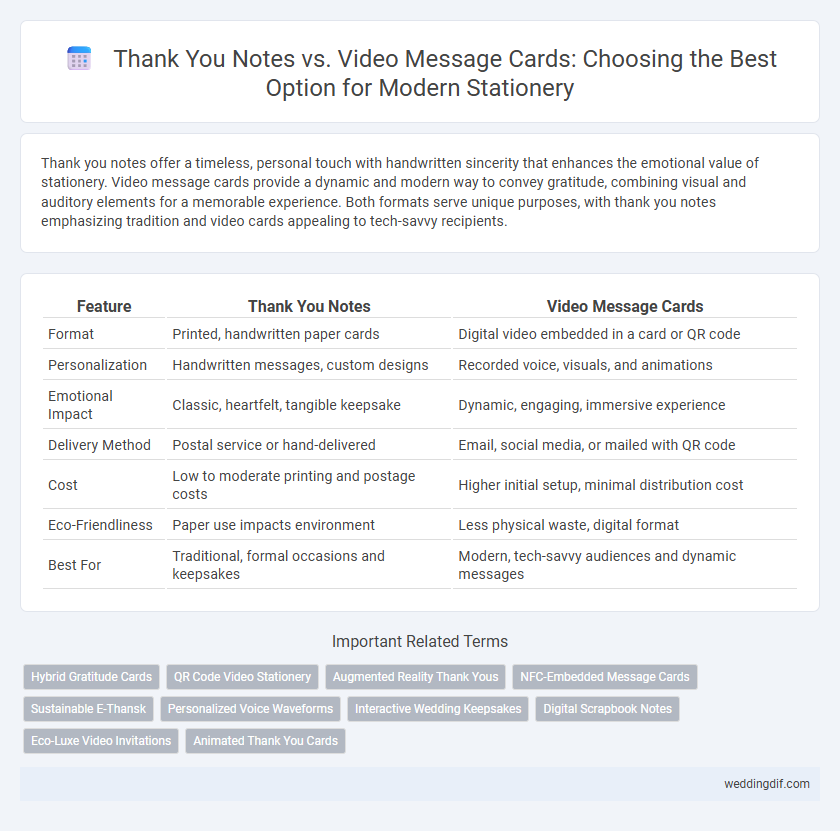Thank you notes offer a timeless, personal touch with handwritten sincerity that enhances the emotional value of stationery. Video message cards provide a dynamic and modern way to convey gratitude, combining visual and auditory elements for a memorable experience. Both formats serve unique purposes, with thank you notes emphasizing tradition and video cards appealing to tech-savvy recipients.
Table of Comparison
| Feature | Thank You Notes | Video Message Cards |
|---|---|---|
| Format | Printed, handwritten paper cards | Digital video embedded in a card or QR code |
| Personalization | Handwritten messages, custom designs | Recorded voice, visuals, and animations |
| Emotional Impact | Classic, heartfelt, tangible keepsake | Dynamic, engaging, immersive experience |
| Delivery Method | Postal service or hand-delivered | Email, social media, or mailed with QR code |
| Cost | Low to moderate printing and postage costs | Higher initial setup, minimal distribution cost |
| Eco-Friendliness | Paper use impacts environment | Less physical waste, digital format |
| Best For | Traditional, formal occasions and keepsakes | Modern, tech-savvy audiences and dynamic messages |
Introduction: Evolving Trends in Wedding Thank You Notes
Wedding thank you notes are evolving from traditional handwritten cards to innovative video message cards that offer a personalized and interactive experience. Stationery trends now emphasize digital customization and multimedia integration to enhance emotional connection and convenience. Couples increasingly choose video message cards for their dynamic storytelling capability and ease of sharing with distant guests.
What Are Traditional Thank You Notes?
Traditional thank you notes are handwritten or printed cards used to express gratitude, often featuring elegant designs and quality paper stock that enhance personalization. These stationery items provide a tangible, lasting keepsake that conveys sincerity and thoughtfulness through carefully chosen words and penmanship. In contrast to digital formats like video message cards, traditional notes emphasize physical interaction and timeless etiquette in personal and professional communication.
Understanding Video Message Cards
Video message cards enhance traditional stationery by incorporating personalized multimedia elements that convey gratitude more vividly. These cards often include customizable templates, embedded videos, and interactive features that increase engagement and emotional impact. The integration of digital technology in video message cards offers a modern alternative to handwritten thank you notes, appealing to tech-savvy users seeking unique and memorable expressions of thanks.
Pros of Traditional Thank You Notes
Traditional thank you notes offer a tactile, personal touch that digital messages cannot replicate, enhancing emotional impact and sincerity. Handwritten notes showcase genuine effort and thoughtfulness, making recipients feel uniquely appreciated and valued. The physical presence of a thank you card also serves as a lasting reminder, often displayed and cherished over time.
Advantages of Video Message Cards
Video message cards enhance personal connection by combining visual and auditory elements, creating a more engaging and memorable expression of gratitude. They allow for customization through animations, music, and voice, making each message unique and impactful. Unlike traditional thank you notes, video cards can be easily shared digitally, increasing convenience and reach.
Personalization: Handwritten Notes vs. Recorded Messages
Thank you notes offer a tangible, handwritten touch that conveys heartfelt sincerity and personal effort, making each message uniquely meaningful. Video message cards provide dynamic, recorded messages that capture tone, facial expressions, and emotions, delivering a more interactive and engaging experience. Both formats enhance personalization, but handwritten notes emphasize traditional craftsmanship while video cards leverage modern technology for expressive communication.
Emotional Impact and Guest Experience
Thank you notes provide a tangible, heartfelt touch that guests can cherish, creating a lasting emotional connection through handwritten sincerity. Video message cards offer dynamic, personalized expressions that engage multiple senses, enhancing guest experience with visual and auditory warmth. Both methods elevate gratitude but differ in emotional depth and memorability, catering to traditional and modern preferences.
Sustainability and Environmental Considerations
Thank you notes crafted from recycled paper or seed-embedded materials reduce waste and promote sustainable practices in stationery. Video message cards, while innovative, require electronic devices and energy consumption, contributing to a larger carbon footprint compared to traditional paper options. Choosing eco-friendly thank you notes supports environmental conservation by minimizing resource use and encouraging biodegradable disposal.
Cost Comparison: Paper vs. Digital Solutions
Thank you notes in traditional stationery often incur costs related to high-quality paper, printing, and postage, making them more expensive per unit compared to digital video message cards. Video message cards eliminate material expenses and postal fees, offering a scalable, cost-effective solution with potential investments in software or app subscriptions. Businesses and individuals seeking budget-friendly options typically favor digital formats for their lower ongoing costs and customizable multimedia features.
Choosing the Right Option for Your Wedding
Thank you notes offer a timeless, personal touch that allows for heartfelt, handwritten messages treasured by wedding guests. Video message cards combine visual and auditory elements, creating memorable, dynamic expressions of gratitude ideal for tech-savvy couples. Selecting between traditional thank you notes and innovative video message cards depends on the desired formality, personalization style, and guest engagement level for your wedding stationery.
Thank You Notes vs Video Message Cards for Stationery Infographic

 weddingdif.com
weddingdif.com